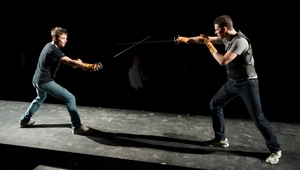SITE GUIDE
REVIEWS
REVIEW ARCHIVES
ADVERTISING AT CURTAINUP
FEATURES
NEWS
Etcetera and
Short Term Listings
LISTINGS
Broadway
Off-Broadway
NYC Restaurants
BOOKS and CDs
OTHER PLACES
Berkshires
London
California
New Jersey
DC
Philadelphia
Elsewhere
QUOTES
TKTS
PLAYWRIGHTS' ALBUMS
LETTERS TO EDITOR
FILM
LINKS
MISCELLANEOUS
Free Updates
Masthead
A CurtainUp Review
Hamlet
|
"
For his passage the soldiers' music and the rites of war speak loudly for him.—
Fortinbras"
|

Josh Carpenter (L) Sean Bradley (R)
(Photo credit: Shawn May) |
Artistic Director Alexander Burns, who directed the play, opened the performance with a brief welcoming speech about how Quintessence wants to build an audience for progressive, classic theater. For a fairly new company, Quintessence approaches Hamlet in a surprisingly traditional way. Although just about every Hamlet production involves cuts to the text in the interest of time and action, the curious thing in this case is the choice made of what to lose. In an interview with newsworks.org, Burns said he wanted an action-packed play that would proceed "from big moment to big moment." Looks like he's following the Elmore Leonard rule: "Skip the Boring Parts."
Just a few things about that. Among the missing are some of the great fun bits. Just one example is Hamlet's riff on being played: Hamlet: "Will you play upon this pipe?". . . Guildenstern: "I have not the skill." . . . Hamlet: "Do you think I'm easier to be played on than a pipe? Call me what instrument you will, though you can fret me, you cannot play upon me."
Key moments that impact on an understanding and appreciation of Hamlet have also been abridged or axed. Among these would be: Polonius and Claudius's eavesdropping on Ophelia; the audience seeing that Polonius is hidden in Gertrude's closet (or curtain) before his accidental murder; Claudius and Laertes discussing the poisoned sword scheme.
Audience lack of knowledge about the secretly poisoned sword lessens key pressures of the duel scene. And the handling of the poisoned cup is so surreptitious that those unfamiliar with the story could be confused. These and other deleted scenes provided clarity and set up dramatic irony and audience anticipation. Without them action scenes don't have the impact that Shakespeare intended.
In addition to cropping, things are shifted around and stitched up. Hamlet's "To Be" soliloquy, for instance, is brought in earlier. The rearrangement, which favors certain character dimensions over others, subtly reduces the complexity that is Hamlet. Was the idea to make way for a more energetic and fiery hero by dealing with inconvenient indecisiveness sooner? If the self-questioning treatise on consciousness vs obliteration is handled earlier-on, you can cunningly shape perceptions and clear the way for a more eager, engaging and hearty Hamlet — less tortured soul and more action figure.
Josh Carpenter has put in the work and labored over imparting the messages of the soliloquies, and it shows. He lets them play out fast, though, and Hamlet becomes fairly histrionic, where a slower delivery would provide a more Hamlet-like counterpoint to the action. On the other hand, this Melancholy Dane has lots of spark, and Carpenter handles the comedy exceptionally well.(Polonius: "Do you know me, my lord?" . . . Hamlet: Excellent well; you are a fishmonger."") Hamlet, in fighting form, attired in a small faux fur jacket and sunglasses, toys with Polonius, who suspects method in his madness. John Preston's Polonius is a rare treat. This may be the best scene in the show. (Sidenote: Preston's take on the gravedigger is notable.)
Rachel Broadeur's low-key Ophelia comes into her own in her mad scenes, and she does justice to David Cope's original song. E. Ashley Izard is a more gracious than usual Gertrude, and Ralph Edmonds' Claudius recalls a quintessential Republican businessman (no offense). Sean Bradley's Laertes emerges well despite a dearth of lines. Matt Lorenz holds his own as Horatio, a kind of thankless role. Daniel Fredrick's Rosencrantz and Osrick are quirky, Alexander Harvey as Guildenstern has good impulses. Griffin Stanton-Ameisen does a fine job in several roles and Sonja Field acquits herself well.
Even with lines tightened up, moved, and key scenes dropped, the performance time isn't trimmed overmuch. It still lasts a fairly typical two and a half hours, not counting intermission. It's interesting to note that with all the cuts, Fortinbras is kept in. This is where many a production chooses to chop. I like seeing Fortinbras onstage at the end, showing the larger frame in which this tragedy has transpired. But would I sacrifice the missing pieces for it? Hmmm.
Burns's sound design ties everything together with well-timed, striking and appropriate thunder, noises and effects. Music, both stark and luminous enhances the production.
The Sedgwick in Mt. Airy was built as an art deco movie palace in 1928. The interior was essentially gutted in the late 60s, except for a few features including some decorative ceilings. Now an arts and cultural center, the Sedgwick offers huge performance spaces. Quintessence, taking full advantage of the deep space, has had two seating areas for the audience constructed at the level of the stage, which runs down the center of the space. The huge, long, wide and sturdy performance platform sits quite high, allowing for groundlings around it. A beautiful piece of construction, the clever and versatile sectional platform is used in a number of ways. During scene shifts a disciplined crew, like a black ops team, moves in, dismantles it, and readies it for the next use. This expert handling between scenes contributes to the professional feel of the show.
|
Hamlet by William Shakespeare
Directed by Alexander Burns Cast: Josh Carpenter, E. Ashley Izard, Ralph Edmonds, John Preston, Rachel Broadeur, Sean Bradley, Matt Lorenz, Daniel Fredrick, Alexander Harvey, Griffin Stanton-Ameisen, Sonja Field Scenic Design: Quintessence Theatre Lighting Design: Ellen Moore Costume Design: Jane Casanave Sound Design: Alexander Burns Original Music: David Cope Oct 9 - Nov 23, 2013 2 and ½ hours including one 15 minute intermission Reviewed by Kathryn Osenlund based on 10/16/2013 performance, Quintessence Theatre Group at Sedgwick Arts & Cultural Center, Germantown Ave, Mt. Airy, Philadelphia |
|
REVIEW FEEDBACK Highlight one of the responses below and click "copy" or"CTRL+C"
Paste the highlighted text into the subject line (CTRL+ V): Feel free to add detailed comments in the body of the email. . .also the names and emails of any friends to whom you'd like us to forward a copy of this review. For a feed to reviews and features as they are posted add http://curtainupnewlinks.blogspot.com to your reader Curtainup at Facebook . . . Curtainup at Twitter Subscribe to our FREE email updates: E-mail: esommer@curtainup.comesommer@curtainup.com put SUBSCRIBE CURTAINUP EMAIL UPDATE in the subject line and your full name and email address in the body of the message. If you can spare a minute, tell us how you came to CurtainUp and from what part of the country. |

|


 Book of Mormon -CD
Book of Mormon -CD